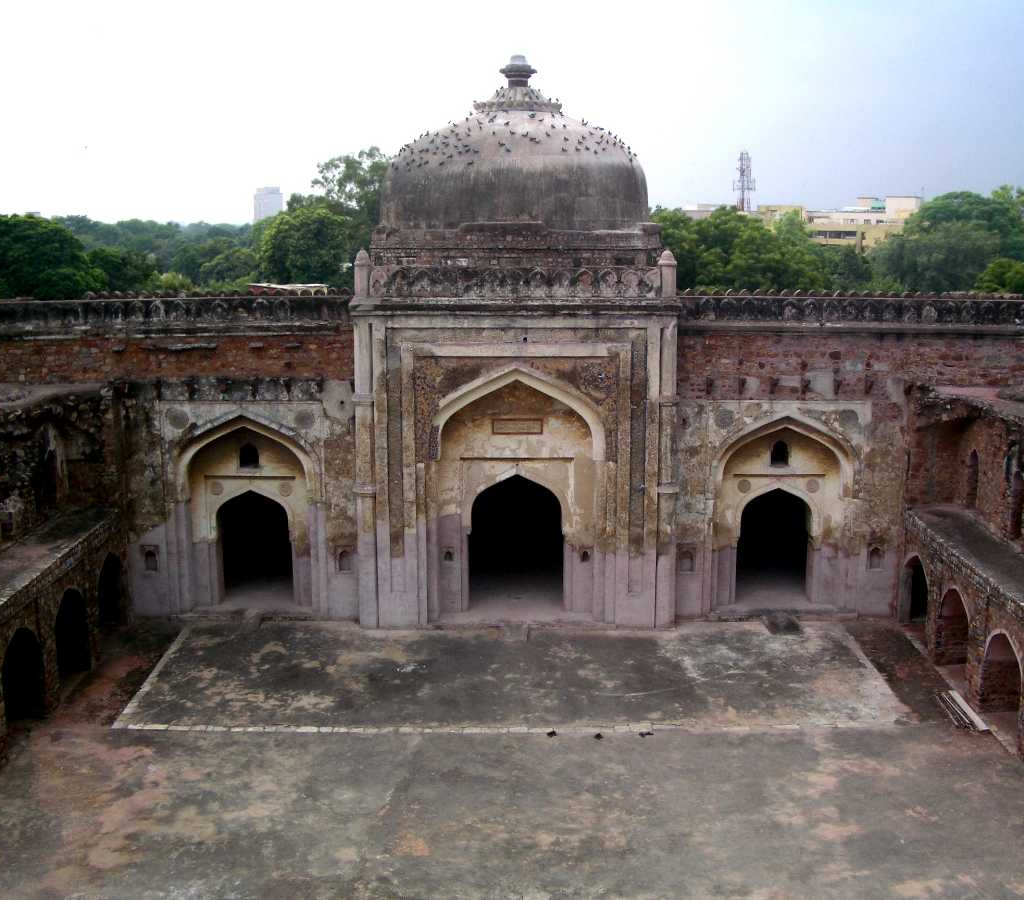Indo-Islamic architecture is a rich and diverse architectural style that emerged in the Indian subcontinent during the medieval period, blending elements of Islamic and indigenous Indian styles. This unique synthesis began with the advent of Islamic rule in the region, particularly during the Delhi Sultanate (1206–1526) and the subsequent Mughal Empire (1526–1857). Characterized by its intricate geometric patterns, calligraphy, and the extensive use of domes and arches, Indo-Islamic architecture reflects a harmonious amalgamation of Persian, Central Asian, and Indian influences. Notable examples include the Qutub Minar in Delhi, a UNESCO World Heritage Site that showcases the early period of Indo-Islamic architecture, and the Taj Mahal in Agra, an iconic masterpiece of the later Mughal era. This architectural style not only served religious purposes, evident in the grand mosques and tombs, but also manifested in palaces, forts, and other structures, leaving a lasting impact on the cultural and architectural heritage of the Indian subcontinent. Indo-Islamic architecture stands as a testament to the artistic and cultural exchange between diverse communities, creating a distinctive visual language that continues to captivate admirers worldwide.
Contents
- 1 Characteristic features of Indo-Islamic form of architecture
- 2 Styles of Islamic architecture in the Indian subcontinent
- 3 Types of buildings in Islamic architecture in the Indian subcontinent
- 4 The evolution of this form of architecture during the medieval period
- 5 FAQs
- 5.1 Q: What is the meaning of Indo-Islamic?
- 5.2 Q: What is Indo-Islamic culture?
- 5.3 Q: What are some key characteristics of Indo-Islamic art and architecture?
- 5.4 Q: What is foreshortening technique in Indo-Islamic architecture?
- 5.5 Q: What are the main features of Indo-Islamic architecture?
- 5.6 For Admissions, talk to our Mentor – 9811333901, 9811333782
Characteristic features of Indo-Islamic form of architecture
Below are the Characteristic features of the Indo-Islamic form of architecture:
- Indo-Islamic buildings were constructed using brick, lime, and mortar.
- The predominant style was arcuate, which utilized arches, domes, and vaults.
- Islamic art avoided human figurines and instead used geometric patterns such as arabesques, floral motifs, and various styles of inscriptions. Inlay on marble, or pietra dura, was also popular.
- Buildings often featured ornamental, perforated lattice screens with arabesques, star motifs, and geometric shapes such as pentagons, hexagons, octagons, and circles.
- Gardens played a significant role in Islamic architecture.
Styles of Islamic architecture in the Indian subcontinent
Imperial Style
Also known as the early Indo-Islamic style, this period saw the conversion of existing buildings into mosques, incorporating elements of ruins from Hindu temples. The palaces were intricately decorated with arches, domes, and Hindu motifs such as floral patterns.
Provincial Style
This style of architecture spanned over two hundred and fifty years, during which buildings were constructed using locally available materials and combining regional styles with Muslim features such as domes, arches, minarets, and mihrabs. Initially, they used the ruins of Hindu and Jain temples, but later they developed their unique style of building art.
Mughal Style
The Mughal style of architecture flourished in India under the patronage of the Mughal Empire during the mid-16th to the 17th century. It is a fusion of Indo-Islamic, Persian, and Turkish influences, resulting in buildings that are remarkably symmetrical and uniform in pattern, with intricate ornamentation.
Types of buildings in Islamic architecture in the Indian subcontinent
Mosques
- Mosques, also known as “masjids“, serve as places of the congregation for Muslim men during prayer.
- They often feature hypostyle halls and may include attached Madrasahs.
- The mihrab, a niche indicating the direction of Mecca, is an important element in mosque architecture.
- Minarets, towers adjacent to or attached to mosques, are used to announce the call to prayer.
- Domes, also known as “qubba“, and calligraphy are commonly used decorative elements in mosques.
Forts
- Forts were built on a larger scale than palaces and served as a city within a city for the monarchs and their people.
- Their primary purpose was defense against enemies.
- Regional influences can be seen in the construction of forts, particularly in Gujarat and Punjab.

Tombs
- The Taj Mahal, a white domed marble structure surrounded by large gardens, pools with fountains, and four tall minarets, is a prime example of the Indo-Islamic style of architecture.
- It represents a balanced and symmetrical form and is an architectural accomplishment of Mughal building art.
- Mumtaz Mahal’s tomb is just one of many beautiful structures built during the Islamic reign in India.
The evolution of this form of architecture during the medieval period
Delhi Sultanate
- The arrival of Turks brought new architectural styles from Persia, Arabia, and Central Asia.
- Engineering features such as domes, arches, and minarets were incorporated into palaces, mosques, and tombs built by rulers.
- Indigenous architecture was blended with new techniques, resulting in a new synthesis.
- Examples include Quwwatul Islam Mosque, Qutub Minar, Hauz Khas, tombs of Mohammad Tughlaq and Firoz Tughlaq, and forts of Tughlaqabad.

Regional Kingdoms
- Regional kingdoms in Bengal, Gujarat, and Deccan developed their architectural styles.
- Examples include Jama Masjid, Sadi Saiyyad Mosque, and shaking towers at Ahmadabad, Jama Masjid, Hindola Mahal, and Jahaz Mahal in Mandu, and Gol Gumbaz at Bijapur.
- Bengal’s distinctive features include oblong structures and peculiar roof construction.
- In Jaunpur, Atala mosque had a gigantic screen covering the dome, while the tomb of Hoshang Shah at Malwa is entirely made of marble with inlay work.
- Bahamani sultans borrowed from styles of Persia, Syria, Turkey, and temples of Southern India.
Mughals
- Mughals introduced a new era in architecture, reaching the zenith of Indo-Islamic architecture.
- Examples include Humayun’s Tomb, forts at Agra and Fatehpur Sikri, Buland Darwaza, the tomb of Salim Chishti, the Palace of Jodha Bai, Ibadat Khana, and Birbal’s House at Fatehpur Sikri.
- Shahjahan was the greatest builder among the Mughals, using marble extensively with decorative inlay work, arches, and minarets.
- Examples include the Red Fort, Jama Masjid, and the Taj Mahal.
- Taj Mahal reflects all architectural features developed during the Mughal period, including the central dome, minarets, gateway, inlay work, and gardens.
- Mughal style influenced later period architecture with courtyards, pillars, and sculpted living beings.


FAQs
Q: What is the meaning of Indo-Islamic?
A: The term “Indo-Islamic” refers to the cultural, artistic, and architectural fusion that emerged in the Indian subcontinent as a result of the Islamic influence on the indigenous Indian traditions. It represents the confluence of Islamic and Indian elements in various aspects of life.
Q: What is Indo-Islamic culture?
A: Indo-Islamic culture is a rich and diverse cultural amalgamation that developed in the Indian subcontinent over several centuries. It encompasses various aspects of life, including art, architecture, music, cuisine, clothing, and religious practices, shaped by the interplay of Islamic and Indian traditions.
Q: What are some key characteristics of Indo-Islamic art and architecture?
A: Indo-Islamic art and architecture are known for their intricate designs, use of geometric patterns, calligraphy, and the incorporation of arches and domes. These elements are combined with traditional Indian motifs to create unique structures and artworks that reflect the fusion of Islamic and Indian aesthetics.
Q: What is foreshortening technique in Indo-Islamic architecture?
A: Foreshortening is a technique used in Indo-Islamic architecture to create an illusion of depth and perspective. It involves the deliberate distortion of the scale and placement of architectural elements, such as columns and arches, to make them appear closer or farther away, giving the viewer a sense of three-dimensionality and depth within a two-dimensional artwork.
Q: What are the main features of Indo-Islamic architecture?
A: Indo-Islamic architecture is characterized by features like intricate geometric patterns, use of arches and domes, minarets, calligraphy, use of local materials, and a harmonious blending of Islamic and Indian architectural styles. It often includes elements like chhatris (pavilions with domed roofs), jali screens (lattice work), and courtyard layouts in structures like mosques, tombs, and palaces.
For UPSC Prelims Resources, Click here
For Daily Updates and Study Material:
Join our Telegram Channel – Edukemy for IAS
- 1. Learn through Videos – here
- 2. Be Exam Ready by Practicing Daily MCQs – here
- 3. Daily Newsletter – Get all your Current Affairs Covered – here
- 4. Mains Answer Writing Practice – here
Visit our YouTube Channel – here

